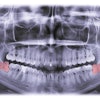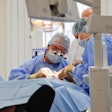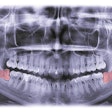
A previous version of this story erroneously conflated antibiotic prophylaxis for prosthetic joint infections and infective endocarditis. The erroneous paragraphs have been removed.
Clinicians may want to stop prescribing antibiotics to patients with prosthetic joints before they undergo invasive dental procedures, because they don't cut the risk of developing infections, according to a study published on December 2 in the Journal of the American Dental Association (JADA).
Continued use of antibiotic prophylaxis puts these patients at risk of adverse drug reactions and promotes antimicrobial resistance in the population, the authors wrote. The study included more than 2,000 people in the U.S. admitted to the hospital with late prosthetic joint infections (LPJIs).
"The use of AP (antibiotic prophylaxis) to prevent LPJIs (late periprosthetic joint infections) should therefore cease," wrote the authors, led by Dr. Martin Thornhill, PhD, an associate professor in the department of oral medicine at Carolinas Medical Center-Atrium Health in Charlotte, NC (JADA, December 2, 2022).
The current study of a U.S. population backs up a U.K. study (which was conducted by many of the same authors) that was published on January 2022 in JAMA Network Open. The U.K. study found no relevant association between invasive dental procedures and subsequent LPJIs, and, therefore, concluded that clinicians may want to reconsider antibiotic prophylaxis.
Digging into the study's details
In the current study, the authors conducted a case-crossover analysis to identify any correlation between invasive dental procedures and LPJIs and whether antibiotics reduce the risk of developing infections after care. Using data from the IBM MarketScan databases, the authors compared invasive dental procedure incidence in the three months immediately before LPJI hospital admission with the preceding 12-month control period for all prosthetic joint infection hospital admissions.
Overall, there were 2,344 patients admitted to the hospital with LPJIs between January 2010 and December 2019. Of those, 1,160 had commercial insurance or Medicare supplemental, and the remaining 1,184 were covered under Medicaid.
In the 15 months before patients were admitted to the hospital for LPJIs, they underwent 4,614 dental treatments, including 1,821 invasive dental procedures. The invasive procedures included oral surgery, endodontics, scaling, and extractions. Of those who had invasive procedures, 333 patients (18%) were prescribed antibiotic prophylaxis, according to the study.
Regardless of the insurance type, no significant increase in the incidence of invasive dental procedures during the three-month case period immediately before admission to the hospital for LPJIs compared with the 12-month control period. When the authors used a one-month or two-month case period, they also identified no increase in incidence.
When they analyzed invasive dental procedures in patients who received preventive antibiotics, there was an increase in the incidence of these procedures in the three months prior to their admission to the hospital for joint infections. However, the increase wasn't noteworthy, the authors wrote.
For patients who underwent invasive dental procedures without antibiotics, the authors detected a small drop in procedures in the three months before LPJIs, they wrote.
Nevertheless, the study was not without limitations, including that the databases used in the analysis encompass a large sample of U.S. employer-provided health insurance and Medicaid enrollees; however, the authors only included those with medical, dental, and prescription benefits coverage. Therefore, the results likely don't represent the entire U.S. population, they wrote.
Since no association could be found between invasive dental procedures and LPJIs, and preventive antibiotics didn't appear to make a difference, clinicians should cease the use of antibiotic prophylaxis to prevent LPJIs, the authors wrote.
"Achieving this will likely require better communication between dentists and orthopedic surgeons and a joint effort to support evidence-based antibiotic stewardship measures," Thornhill and colleagues wrote.




















